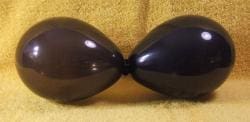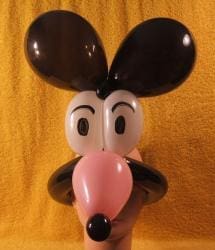Ori Livney: Balloon Pioneer
Mouse Hat
by Ralph Dewey
Ori Livney from Israel is a balloon pioneer. While other balloon artists have appeared on TV in the past, Ori is the first to have his own balloon TV show. A few years ago Ori was contacted by the Baby First TV show which had a branch office in Israel. They were interested in having a show featuring a balloon artist that targeted one-year old children. They started searching, interviewing and auditioning for the right person. Ori had the personality and balloon skills that they were seeking. They were interested in his ideas and discussed the possible format of the balloon show. He suggested variety of balloon animals that might be used and let them pick what they wanted. The next step after the auditions was to shoot a pilot. Once that was done and approved, Baby First scheduled to shoot more than 30 episodes at their studio in Israel. The entire series of episodes was shot in 3 days. They filmed about12 or 13 episodes each day. Their awkward production method required Ori to do everything twice which he found a bit irritating. The first shoot for each episode included both him and the children. It was a challenge to keep the kids excited during all of the camera shots especially with a long boring day of shooting. Then the second shooting was done in order to capture close-ups and various other camera angles. Each episode would be end up 5 minutes long which included the opener at the front and the credits at the end. Their format didn’t require Ori to have any speaking lines. He interacted with the children and made balloon creations. The producers decided to name it Bobby’s Balloon House to give it an international appeal. Even though it was shot in Israel, Baby First did not plan to air it in that country. It would be shown in the USA, Europe and all over the world. Ori wasn’t paid a royalty for his efforts, instead he was paid by the hour at a decent rate for his time in the studio. He had a two-year exclusive contract with Baby First.
With the success of Bobby’s Balloon House other opportunities emerged. He did all of the great balloons used in the Orange commercial. Ori did two Orange commercials. The first one won a silver medal in communication at the NY Advertising Festival. It broke all records for being memorable. He is proud of his balloon work because he thinks that it portrays balloons in the correct way. In addition to the Orange commercials, Ori also made large balloon dragon for a Volkswagen Golf TV commercial which took 14 hours of twisting balloons to complete.
After his contract was up with the Baby First network, he approached a competing network about working for them which resulted in him starring in the Loony Balloon Show. So the Loony Balloon Show was Ori’s second balloon TV show, another record. Each episode of his second TV show used balloons to tell a different story. The production of this show was much better because the producers spent 6 to 10 times more money than the Baby First show. Embassy kids were used to get a variety of ethnic faces so it would fit anywhere in the world. Ori enjoyed working with the kids because they were nice and polite. The target age for the Loony Balloon Show was one-year olds but also up to two-year olds. In these episodes Ori didn’t have to speak any lines. Instead they used music and sound effects so that the show would be more universal for worldwide distribution. The production schedule was fairly intense. Half of the episodes were shot on the first day of shooting, then they took off a week. The rest of the episodes were shot on the second full day of production. They ended up with about 26 to 30 total episodes. A script writer worked with Ori to write each story. Ori advised him as to what was feasible to do with the balloons. Some of the balloon creations were used in several episodes, like the balloon table. Items like the table took a long time to make so they were sometimes used both for the table for preparing dinner and for the birthday cake table. Ori designed all of the balloons for the show. Even though he made most of the balloons himself, he did get some help from Sandi Masori and a few other twisters. It was very hard work, but very rewarding too. It was acting, miming and working with the kids. He was complimented by a kid’s performer on how well he interacted with the kids. It took about 30 to 45 minute for each episode and then it got edited and cut down to 5 minutes. Most of the shows were done in one take. He found it a bit tricky working with kids because you have to keep them interested and cooperative all day long even when they are getting tired. It’s a very demanding job to do all of that plus do a good job of twisting balloons. The pay arrangement was similar to the Baby First TV show.
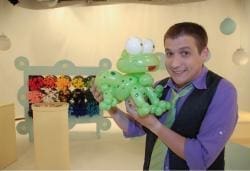
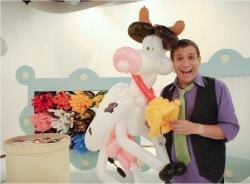
Ori is proud of his TV work and finds it rewarding to know that hundreds of thousands of the kids like the show and are interested in it. It gives him a good feeling. With his TV fame, sometimes he gets recognized. He found out that older kids like his balloons on TV and the parents loved it even more than the kids because they appreciated the balloon art. After the show aired, there were times Ori would get bookings for children’s parties. If they had a baby brother or sister who had seen the show, they were real glad to see him. Ori would get a celebrity-style welcome. When they saw Ori perform, he got to see their reaction in person. It is amazing. The little kids would get so excited when they heard the music. It was almost like the kids were hypnotized.
Ori has more projects that he is hoping to pursue, but he doesn’t want to announce them before they are finalized. He likes to keep moving forward. Ori says, “It’s not about being first, it’s about the challenge. Like Star Trek, going where no man’s gone before.”
Ori says, “When I was a little kid, my nanny told my mother that she never heard of a kid so young where every other sentence was, ‘I have an idea.'” So Ideas have never been a problem for Ori. One of the things that he has learned from his experiences with the video productions is that he should spend a good amount of time doing something that has an ongoing effect. So now that is what he tries to do with his projects. He tries to make the most of the time he spends working on it. For example, if you do a birthday party or show and it ends, it is over, it’s done. But when you produce something that has a life of its own and keeps on going and has a positive effect on people and they see it and like it and it presents balloons in a positive way, that is his goal. Experience has taught him that it is possible to do that. And now his challenge is to do it better. Once some people from a TV show approached him and wanted him to make balloon genitalia for their TV show. But he refused because it wouldn’t put balloon art in a positive light. Ori thinks that whenever you get a chance to do balloons or balloon decor on air, do your very best to put balloons in a good light. If you discover that you are in over your head, ask for help from your balloon friends so that balloon art looks good. Lately Ori has been very busy with his balloon work and hasn’t been able to participate much with the balloon community, so that is why he hasn’t been able to attend many conventions.
By profession Ori is an industrial engineer, but for more than 10 years he has excelled as a balloon artist and innovator. Ori Livney has put some of his balloon knowledge into a DVD called Figure It Out! It explains Ori’s unique approach to help you develop your skills to create your own sculptures just by looking at a subject. His advanced principles, which would be beneficial to all balloon skill levels, are in his 84 minute DVD which is available from Ed Chee at DiamondStorm Inc. If anyone has questions or comments about his balloon projects or just wants to know something about him, he invites you to contact him.
Ori’s Email: [email protected]
Ori Livney Links
http://www.youtube.com/watch?v=J9RUemkmVpM The making of the Orange Commercial.
http://www.youtube.com/watch?v=zSkCgKxUj1g&NR=1 The second Orange Commercial.
http://www1.babyfirsttv.com/tv/program/bobby%60s-balloon-house/264 Bobby’s Balloon House
http://www.youtube.com/watch?v=tgGTqVRDB8k Loony Balloon
http://www.balloonfashion.com/Balloon_projects.html
www.balloonfashion.com
www.balonim.com
http://www.youtube.com/watch?v=MlsPll-qbug
Mouse Hat
The BHQ Challenge this month is a mouse or rodent design.
Here is a hat design that will please the kids. It requires a black #260 balloon, a pink 6″ heart, a white #321, two 5″ black round balloons, the nipple end of a black #260 and a couple of three inch #260 scraps.
Headband
Fully inflate the black #260 except for a 1/4″ and tie off the nozzle. For an adult-sized head, you may need to stretch the balloon several times to gain additional length. Twist off a1/2″ bubble and a loop that will encircle your head. Twist off a 5″ bubble and then make a 1-1/2″ ear twist. Twist off a 1″ bubble at the nipple end and connect it to the opposite side of the headband loop.
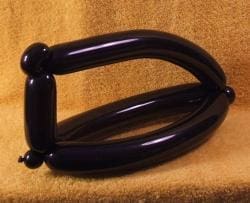
Eyes
Inflate the white #321 to about 10″ and tie off the nozzle. Twist and divide the balloon to make two 5″ bubbles. Connect to the first 1/2″ bubble on the head band and the 1-1/2″ ear twist. Tuck the 1″ bubble inside the headband.

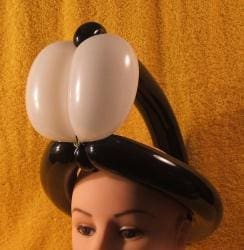
Nose/Muzzle
Using about 2″ of a black #260, inflate it to about 2″ for the nose. Inflate a pink 6″ heart to about 60% full. Then tie their nozzles together. This will make only one knot. Trim off the excess balloon around the knot. I have used rubber cement, glue dots and raisin knots the past to attach the muzzle to the headband, but this time I’ll show you how to do it another way. Twist off a small bubble on each lobe of the heart and tightly tie a scrap of a #260 around it. Stretch the scraps and tie them around the 1″ bubble of the headband.
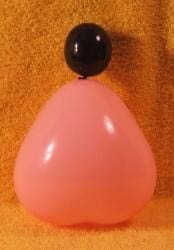
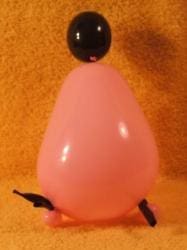
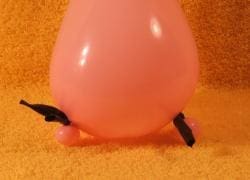
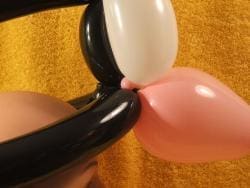
Ears
Fully inflate both 5″ black round balloons and tie them together at their nozzles. Place them at the top of the headband next to the 1-1/2″ ear twist. Mark the eyes with a black marking pen.
